Business Professional Development: Self-Awareness, Values, Emotional Intelligence, Leadership and Decision Making
VerifiedAdded on 2023/06/05
|17
|3967
|83
AI Summary
This report highlights self-awareness, values, emotional intelligence, leadership and decision making. It provides an understanding of various theories like Emotional Intelligence, Emotional Labour, The Myth of Rationality, the concept of Leadership and the various Theories of Leadership. It also provides an understanding of concepts like Power, Politics and Influence, Problem Solving and Decision Making.
Contribute Materials
Your contribution can guide someone’s learning journey. Share your
documents today.
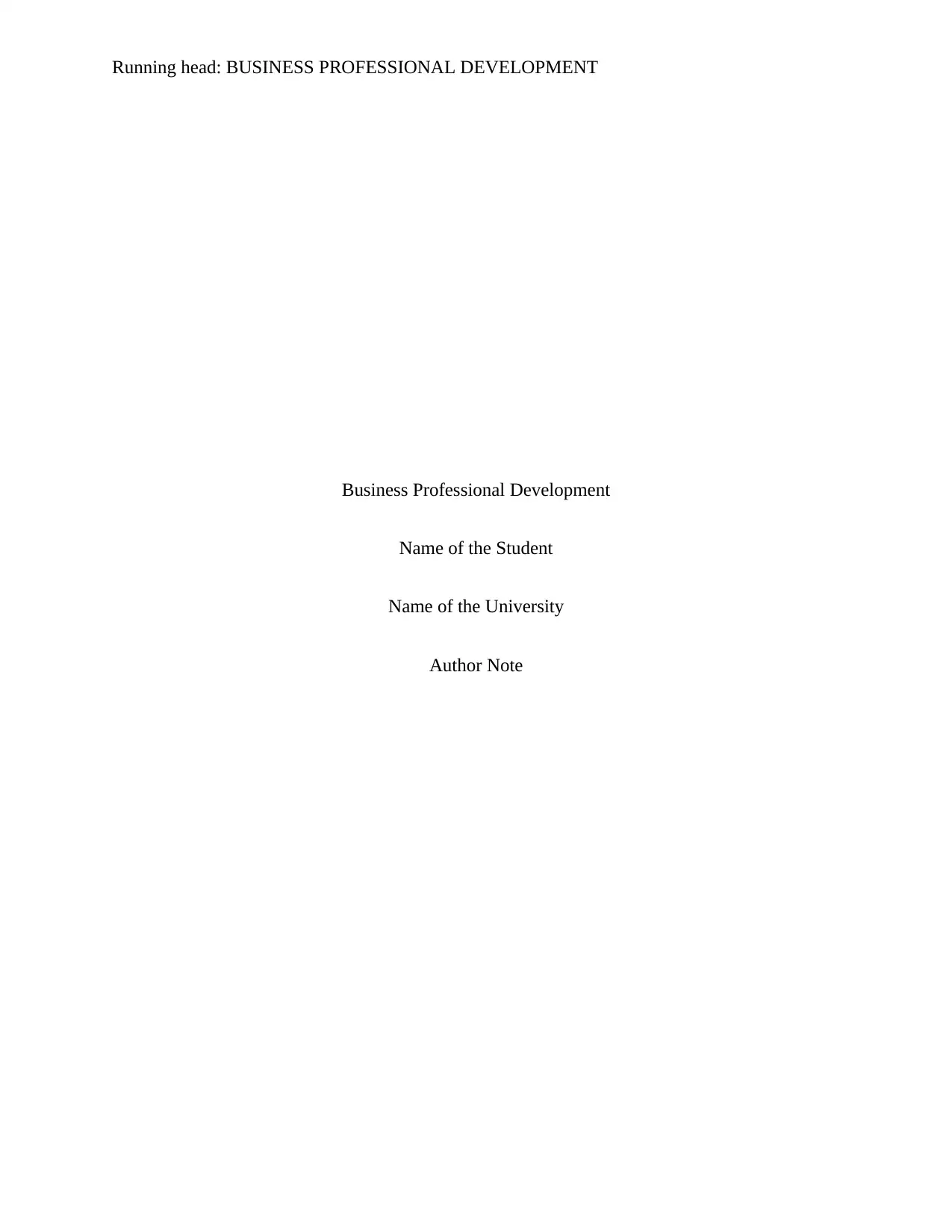
Running head: BUSINESS PROFESSIONAL DEVELOPMENT
Business Professional Development
Name of the Student
Name of the University
Author Note
Business Professional Development
Name of the Student
Name of the University
Author Note
Secure Best Marks with AI Grader
Need help grading? Try our AI Grader for instant feedback on your assignments.
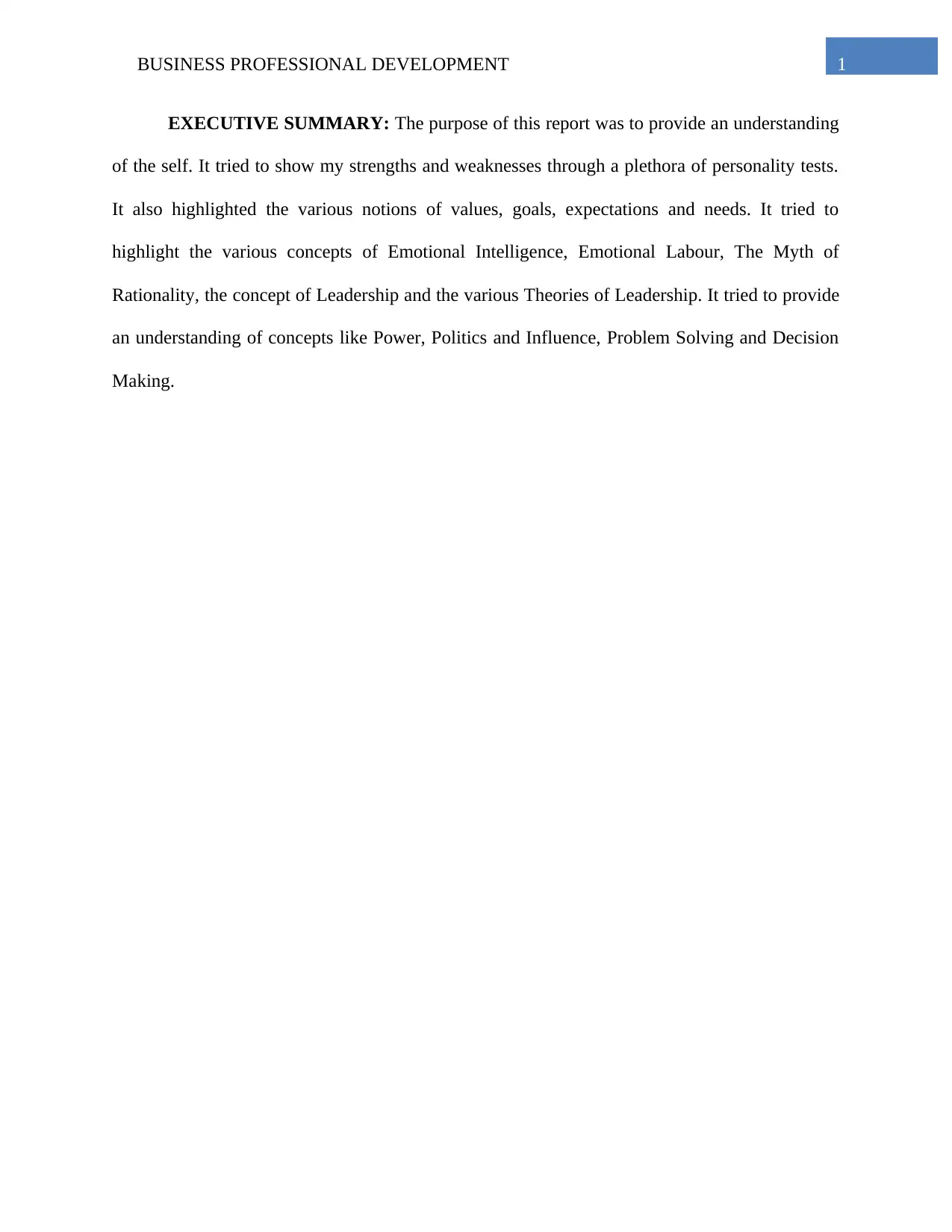
1BUSINESS PROFESSIONAL DEVELOPMENT
EXECUTIVE SUMMARY: The purpose of this report was to provide an understanding
of the self. It tried to show my strengths and weaknesses through a plethora of personality tests.
It also highlighted the various notions of values, goals, expectations and needs. It tried to
highlight the various concepts of Emotional Intelligence, Emotional Labour, The Myth of
Rationality, the concept of Leadership and the various Theories of Leadership. It tried to provide
an understanding of concepts like Power, Politics and Influence, Problem Solving and Decision
Making.
EXECUTIVE SUMMARY: The purpose of this report was to provide an understanding
of the self. It tried to show my strengths and weaknesses through a plethora of personality tests.
It also highlighted the various notions of values, goals, expectations and needs. It tried to
highlight the various concepts of Emotional Intelligence, Emotional Labour, The Myth of
Rationality, the concept of Leadership and the various Theories of Leadership. It tried to provide
an understanding of concepts like Power, Politics and Influence, Problem Solving and Decision
Making.
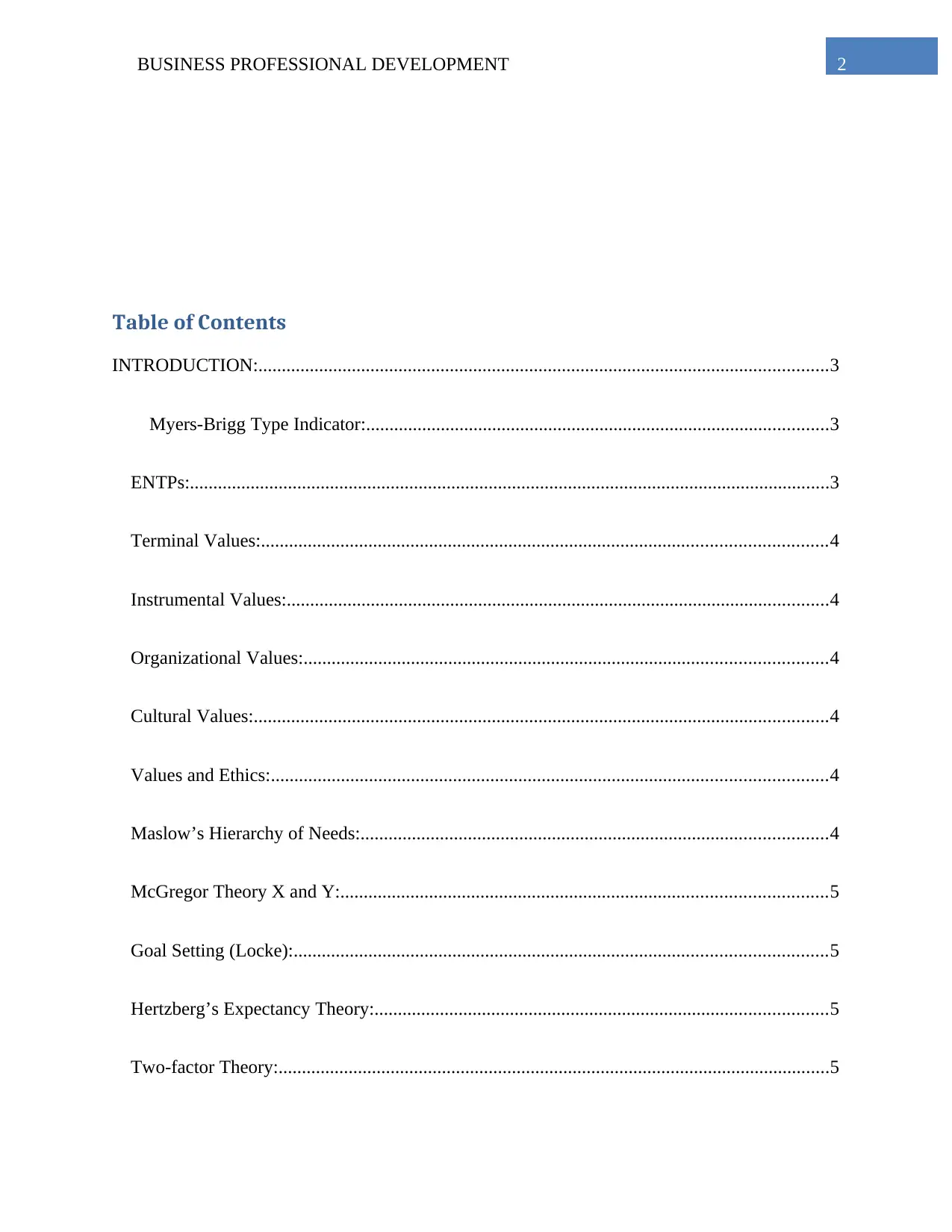
2BUSINESS PROFESSIONAL DEVELOPMENT
Table of Contents
INTRODUCTION:..........................................................................................................................3
Myers-Brigg Type Indicator:...................................................................................................3
ENTPs:.........................................................................................................................................3
Terminal Values:.........................................................................................................................4
Instrumental Values:....................................................................................................................4
Organizational Values:................................................................................................................4
Cultural Values:...........................................................................................................................4
Values and Ethics:.......................................................................................................................4
Maslow’s Hierarchy of Needs:....................................................................................................4
McGregor Theory X and Y:........................................................................................................5
Goal Setting (Locke):..................................................................................................................5
Hertzberg’s Expectancy Theory:.................................................................................................5
Two-factor Theory:......................................................................................................................5
Table of Contents
INTRODUCTION:..........................................................................................................................3
Myers-Brigg Type Indicator:...................................................................................................3
ENTPs:.........................................................................................................................................3
Terminal Values:.........................................................................................................................4
Instrumental Values:....................................................................................................................4
Organizational Values:................................................................................................................4
Cultural Values:...........................................................................................................................4
Values and Ethics:.......................................................................................................................4
Maslow’s Hierarchy of Needs:....................................................................................................4
McGregor Theory X and Y:........................................................................................................5
Goal Setting (Locke):..................................................................................................................5
Hertzberg’s Expectancy Theory:.................................................................................................5
Two-factor Theory:......................................................................................................................5
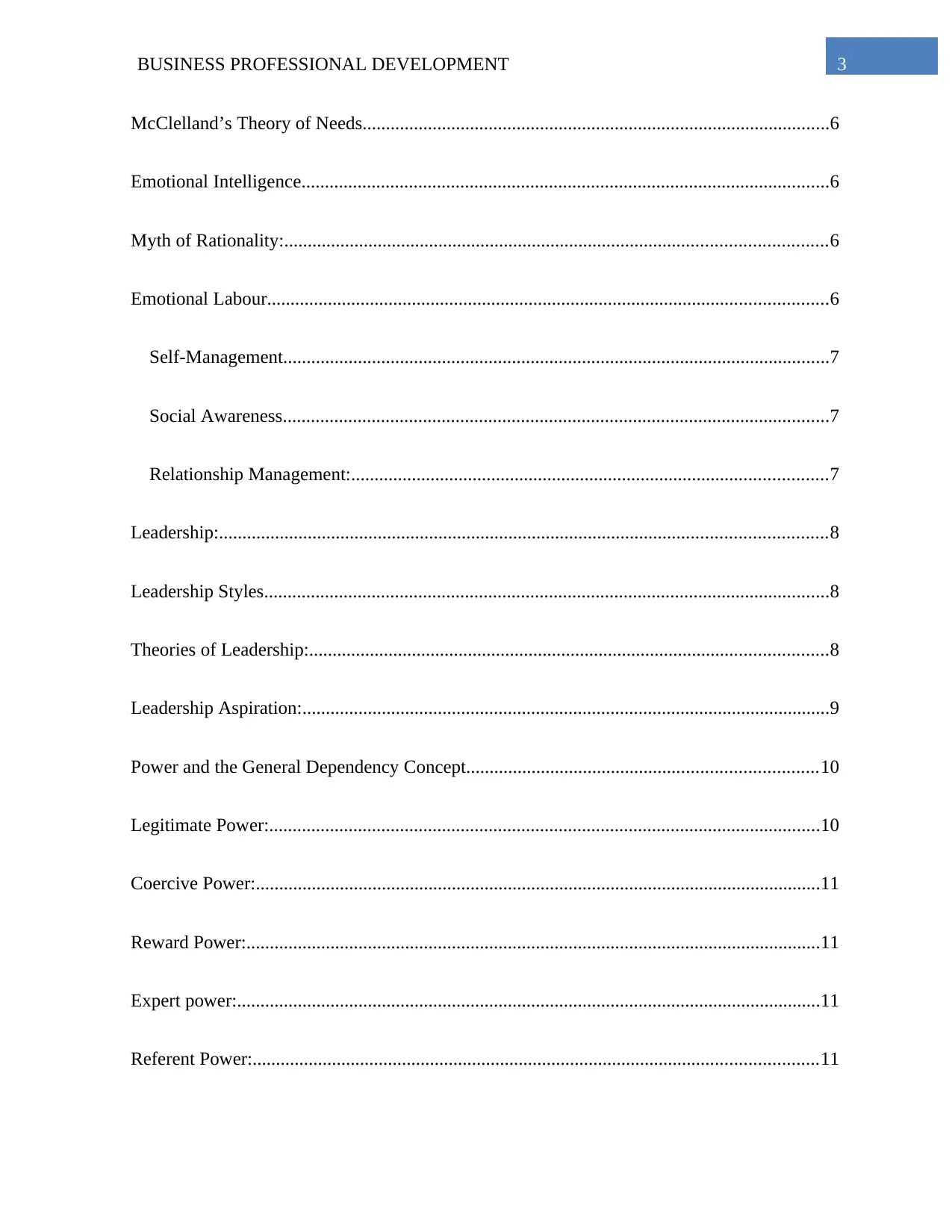
3BUSINESS PROFESSIONAL DEVELOPMENT
McClelland’s Theory of Needs....................................................................................................6
Emotional Intelligence.................................................................................................................6
Myth of Rationality:....................................................................................................................6
Emotional Labour........................................................................................................................6
Self-Management.....................................................................................................................7
Social Awareness.....................................................................................................................7
Relationship Management:......................................................................................................7
Leadership:..................................................................................................................................8
Leadership Styles.........................................................................................................................8
Theories of Leadership:...............................................................................................................8
Leadership Aspiration:.................................................................................................................9
Power and the General Dependency Concept...........................................................................10
Legitimate Power:......................................................................................................................10
Coercive Power:.........................................................................................................................11
Reward Power:...........................................................................................................................11
Expert power:.............................................................................................................................11
Referent Power:.........................................................................................................................11
McClelland’s Theory of Needs....................................................................................................6
Emotional Intelligence.................................................................................................................6
Myth of Rationality:....................................................................................................................6
Emotional Labour........................................................................................................................6
Self-Management.....................................................................................................................7
Social Awareness.....................................................................................................................7
Relationship Management:......................................................................................................7
Leadership:..................................................................................................................................8
Leadership Styles.........................................................................................................................8
Theories of Leadership:...............................................................................................................8
Leadership Aspiration:.................................................................................................................9
Power and the General Dependency Concept...........................................................................10
Legitimate Power:......................................................................................................................10
Coercive Power:.........................................................................................................................11
Reward Power:...........................................................................................................................11
Expert power:.............................................................................................................................11
Referent Power:.........................................................................................................................11
Secure Best Marks with AI Grader
Need help grading? Try our AI Grader for instant feedback on your assignments.
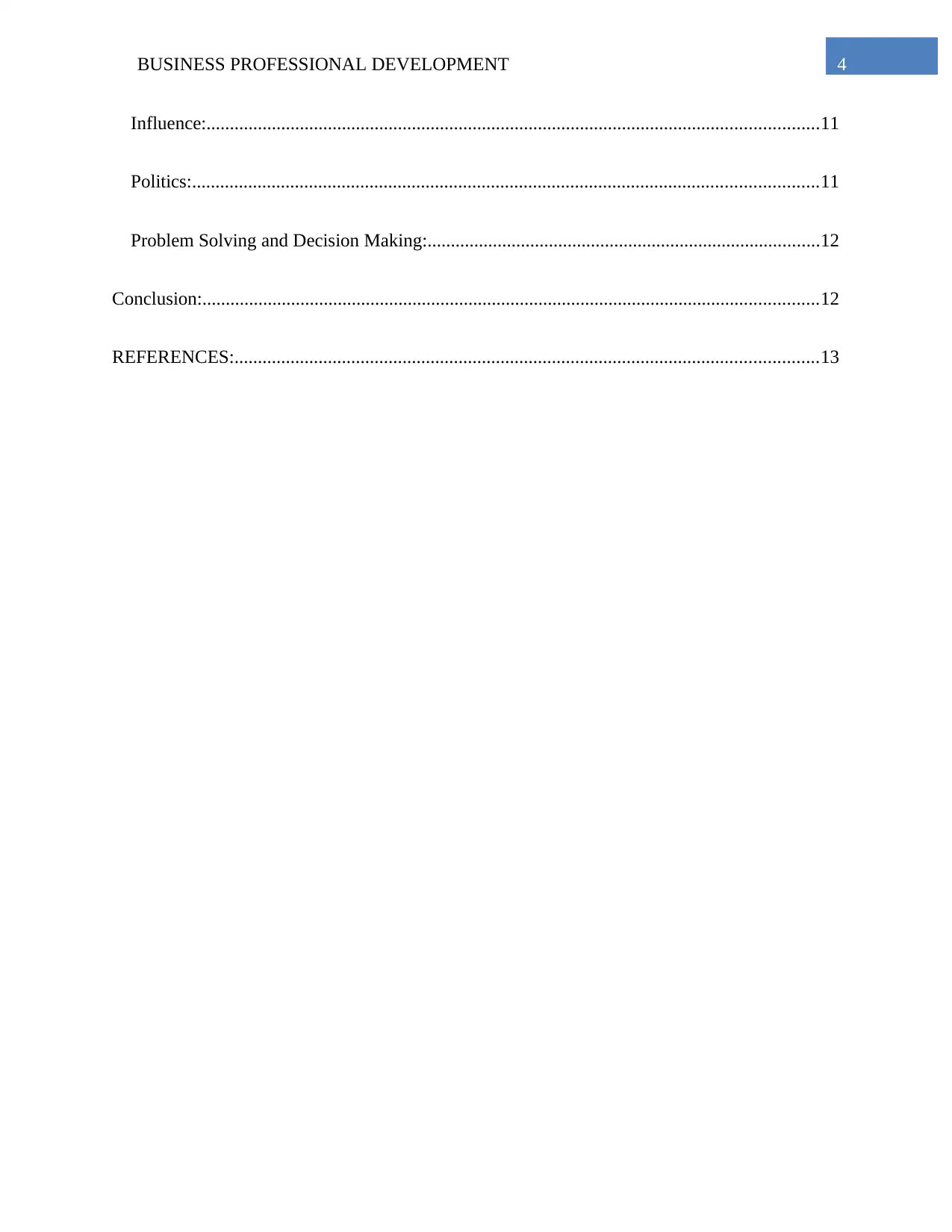
4BUSINESS PROFESSIONAL DEVELOPMENT
Influence:...................................................................................................................................11
Politics:......................................................................................................................................11
Problem Solving and Decision Making:....................................................................................12
Conclusion:....................................................................................................................................12
REFERENCES:.............................................................................................................................13
Influence:...................................................................................................................................11
Politics:......................................................................................................................................11
Problem Solving and Decision Making:....................................................................................12
Conclusion:....................................................................................................................................12
REFERENCES:.............................................................................................................................13
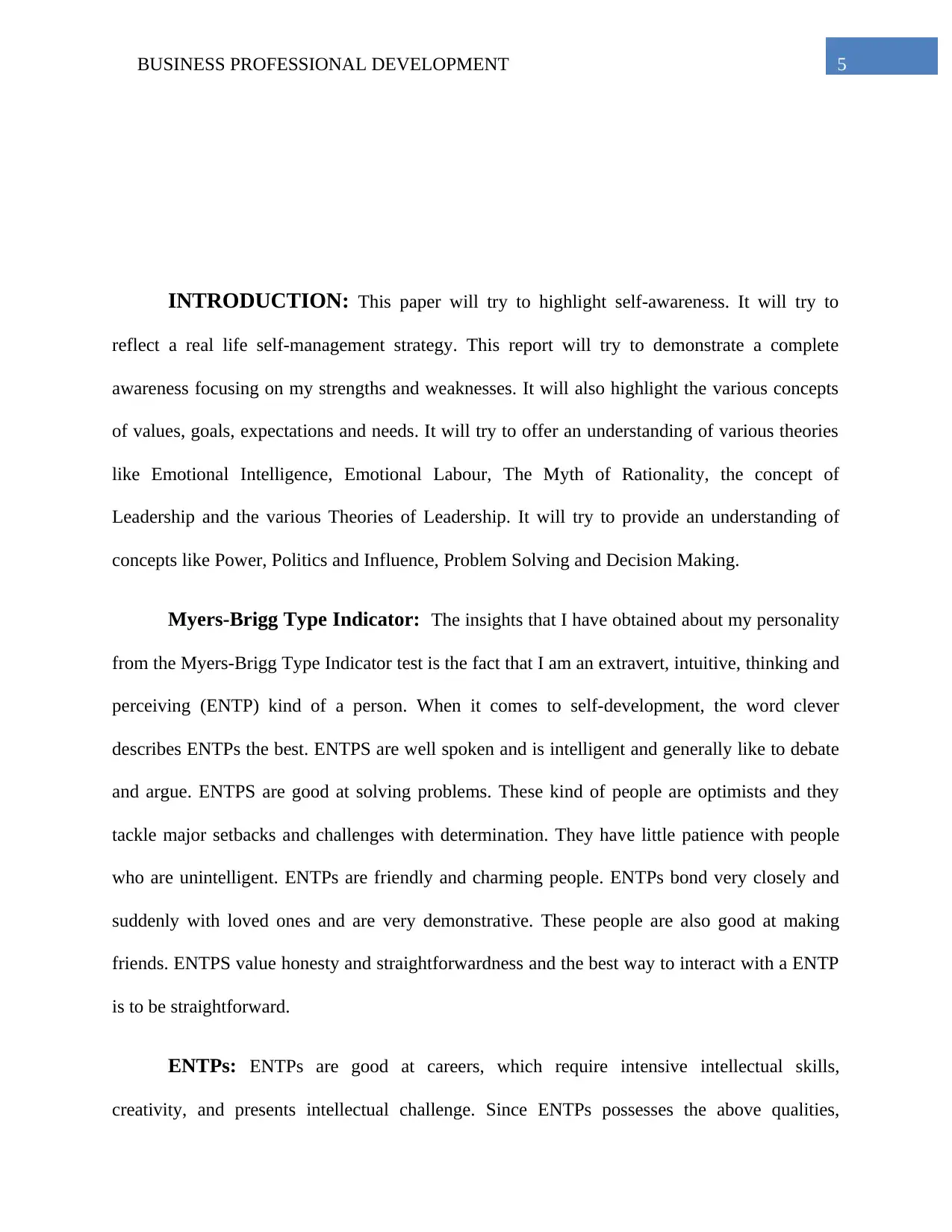
5BUSINESS PROFESSIONAL DEVELOPMENT
INTRODUCTION: This paper will try to highlight self-awareness. It will try to
reflect a real life self-management strategy. This report will try to demonstrate a complete
awareness focusing on my strengths and weaknesses. It will also highlight the various concepts
of values, goals, expectations and needs. It will try to offer an understanding of various theories
like Emotional Intelligence, Emotional Labour, The Myth of Rationality, the concept of
Leadership and the various Theories of Leadership. It will try to provide an understanding of
concepts like Power, Politics and Influence, Problem Solving and Decision Making.
Myers-Brigg Type Indicator: The insights that I have obtained about my personality
from the Myers-Brigg Type Indicator test is the fact that I am an extravert, intuitive, thinking and
perceiving (ENTP) kind of a person. When it comes to self-development, the word clever
describes ENTPs the best. ENTPS are well spoken and is intelligent and generally like to debate
and argue. ENTPS are good at solving problems. These kind of people are optimists and they
tackle major setbacks and challenges with determination. They have little patience with people
who are unintelligent. ENTPs are friendly and charming people. ENTPs bond very closely and
suddenly with loved ones and are very demonstrative. These people are also good at making
friends. ENTPS value honesty and straightforwardness and the best way to interact with a ENTP
is to be straightforward.
ENTPs: ENTPs are good at careers, which require intensive intellectual skills,
creativity, and presents intellectual challenge. Since ENTPs possesses the above qualities,
INTRODUCTION: This paper will try to highlight self-awareness. It will try to
reflect a real life self-management strategy. This report will try to demonstrate a complete
awareness focusing on my strengths and weaknesses. It will also highlight the various concepts
of values, goals, expectations and needs. It will try to offer an understanding of various theories
like Emotional Intelligence, Emotional Labour, The Myth of Rationality, the concept of
Leadership and the various Theories of Leadership. It will try to provide an understanding of
concepts like Power, Politics and Influence, Problem Solving and Decision Making.
Myers-Brigg Type Indicator: The insights that I have obtained about my personality
from the Myers-Brigg Type Indicator test is the fact that I am an extravert, intuitive, thinking and
perceiving (ENTP) kind of a person. When it comes to self-development, the word clever
describes ENTPs the best. ENTPS are well spoken and is intelligent and generally like to debate
and argue. ENTPS are good at solving problems. These kind of people are optimists and they
tackle major setbacks and challenges with determination. They have little patience with people
who are unintelligent. ENTPs are friendly and charming people. ENTPs bond very closely and
suddenly with loved ones and are very demonstrative. These people are also good at making
friends. ENTPS value honesty and straightforwardness and the best way to interact with a ENTP
is to be straightforward.
ENTPs: ENTPs are good at careers, which require intensive intellectual skills,
creativity, and presents intellectual challenge. Since ENTPs possesses the above qualities,
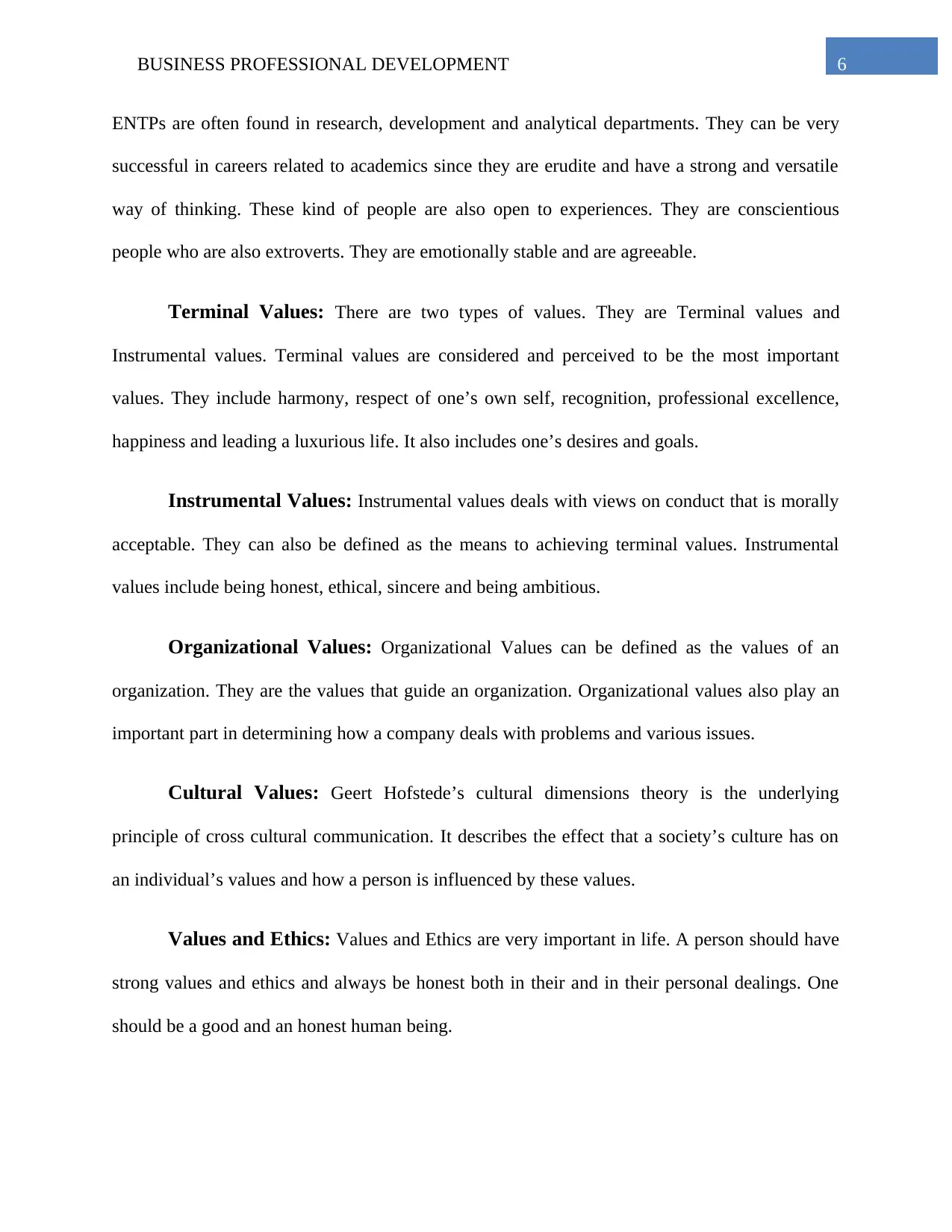
6BUSINESS PROFESSIONAL DEVELOPMENT
ENTPs are often found in research, development and analytical departments. They can be very
successful in careers related to academics since they are erudite and have a strong and versatile
way of thinking. These kind of people are also open to experiences. They are conscientious
people who are also extroverts. They are emotionally stable and are agreeable.
Terminal Values: There are two types of values. They are Terminal values and
Instrumental values. Terminal values are considered and perceived to be the most important
values. They include harmony, respect of one’s own self, recognition, professional excellence,
happiness and leading a luxurious life. It also includes one’s desires and goals.
Instrumental Values: Instrumental values deals with views on conduct that is morally
acceptable. They can also be defined as the means to achieving terminal values. Instrumental
values include being honest, ethical, sincere and being ambitious.
Organizational Values: Organizational Values can be defined as the values of an
organization. They are the values that guide an organization. Organizational values also play an
important part in determining how a company deals with problems and various issues.
Cultural Values: Geert Hofstede’s cultural dimensions theory is the underlying
principle of cross cultural communication. It describes the effect that a society’s culture has on
an individual’s values and how a person is influenced by these values.
Values and Ethics: Values and Ethics are very important in life. A person should have
strong values and ethics and always be honest both in their and in their personal dealings. One
should be a good and an honest human being.
ENTPs are often found in research, development and analytical departments. They can be very
successful in careers related to academics since they are erudite and have a strong and versatile
way of thinking. These kind of people are also open to experiences. They are conscientious
people who are also extroverts. They are emotionally stable and are agreeable.
Terminal Values: There are two types of values. They are Terminal values and
Instrumental values. Terminal values are considered and perceived to be the most important
values. They include harmony, respect of one’s own self, recognition, professional excellence,
happiness and leading a luxurious life. It also includes one’s desires and goals.
Instrumental Values: Instrumental values deals with views on conduct that is morally
acceptable. They can also be defined as the means to achieving terminal values. Instrumental
values include being honest, ethical, sincere and being ambitious.
Organizational Values: Organizational Values can be defined as the values of an
organization. They are the values that guide an organization. Organizational values also play an
important part in determining how a company deals with problems and various issues.
Cultural Values: Geert Hofstede’s cultural dimensions theory is the underlying
principle of cross cultural communication. It describes the effect that a society’s culture has on
an individual’s values and how a person is influenced by these values.
Values and Ethics: Values and Ethics are very important in life. A person should have
strong values and ethics and always be honest both in their and in their personal dealings. One
should be a good and an honest human being.
Paraphrase This Document
Need a fresh take? Get an instant paraphrase of this document with our AI Paraphraser

7BUSINESS PROFESSIONAL DEVELOPMENT
Maslow’s Hierarchy of Needs: In psychology, Maslow’s hierarchy of needs is a
motivational theory which consists of a five tier model of human needs. The needs that are at the
bottom of the pyramid must be met before an individual can aspire to achieve the needs which
are the top of the pyramid. From the bottom of the hierarchy upwards are Physiological needs,
Safety needs, Belongingness and love needs, Esteem needs, and Self-actualization. Physiological
needs consists of water, food, rest and warmth. Safety needs comprises the need for safety and
security. Esteem needs are needs that arises from the need of prestige and feeling of
accomplishment and self-actualization needs are the needs to achieve one’s full potential and
also include the need for creative activities.
McGregor Theory X and Y: Both Douglas McGregor’s Theory X and Y and
Maslow’s hierarchy of needs are motivational needs. Theory X and Y can be defined as theories
of work motivation and management. The importance of supervision, penalties and rewards is
stressed by Theory X while Theory Y lays importance on the satisfaction of job and instructs
workers to approach a job without any direct supervision.
Goal Setting (Locke): Goal setting by Edwin A. Locke entails an action plan, that is
designed to motivate and guide an individual or a group towards growth. Goal setting is an
important part of personal development and management literature. Studies have shown that
goals which are specific and ambitious lead to a greater performance improvement than general
and easy goals (Jones-Rickkers 2014).
Hertzberg’s Expectancy Theory: This theory is based on the thought that people
chooses a particular behaviour that is based on the expectations of the intended result. This
theory is important to the study of management.
Maslow’s Hierarchy of Needs: In psychology, Maslow’s hierarchy of needs is a
motivational theory which consists of a five tier model of human needs. The needs that are at the
bottom of the pyramid must be met before an individual can aspire to achieve the needs which
are the top of the pyramid. From the bottom of the hierarchy upwards are Physiological needs,
Safety needs, Belongingness and love needs, Esteem needs, and Self-actualization. Physiological
needs consists of water, food, rest and warmth. Safety needs comprises the need for safety and
security. Esteem needs are needs that arises from the need of prestige and feeling of
accomplishment and self-actualization needs are the needs to achieve one’s full potential and
also include the need for creative activities.
McGregor Theory X and Y: Both Douglas McGregor’s Theory X and Y and
Maslow’s hierarchy of needs are motivational needs. Theory X and Y can be defined as theories
of work motivation and management. The importance of supervision, penalties and rewards is
stressed by Theory X while Theory Y lays importance on the satisfaction of job and instructs
workers to approach a job without any direct supervision.
Goal Setting (Locke): Goal setting by Edwin A. Locke entails an action plan, that is
designed to motivate and guide an individual or a group towards growth. Goal setting is an
important part of personal development and management literature. Studies have shown that
goals which are specific and ambitious lead to a greater performance improvement than general
and easy goals (Jones-Rickkers 2014).
Hertzberg’s Expectancy Theory: This theory is based on the thought that people
chooses a particular behaviour that is based on the expectations of the intended result. This
theory is important to the study of management.
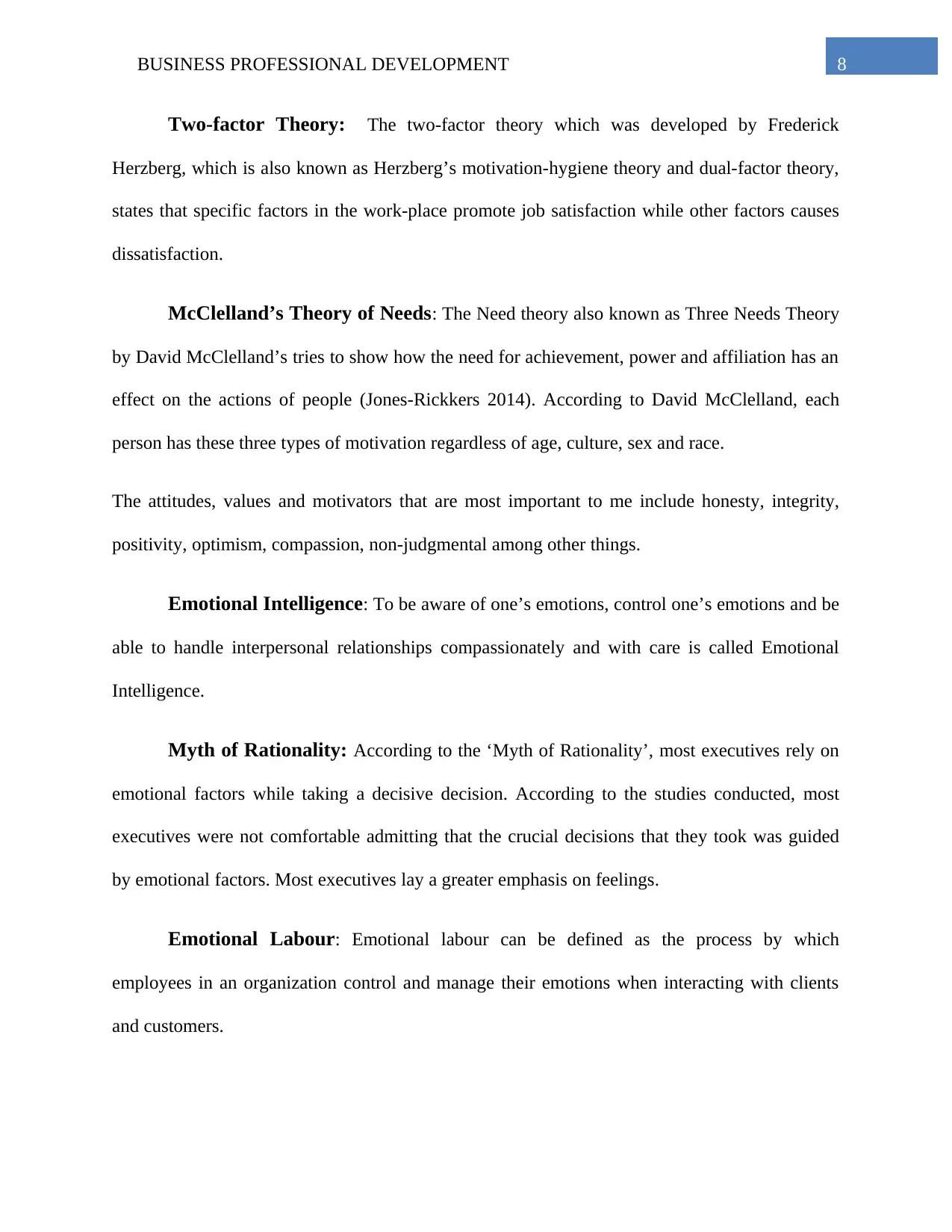
8BUSINESS PROFESSIONAL DEVELOPMENT
Two-factor Theory: The two-factor theory which was developed by Frederick
Herzberg, which is also known as Herzberg’s motivation-hygiene theory and dual-factor theory,
states that specific factors in the work-place promote job satisfaction while other factors causes
dissatisfaction.
McClelland’s Theory of Needs: The Need theory also known as Three Needs Theory
by David McClelland’s tries to show how the need for achievement, power and affiliation has an
effect on the actions of people (Jones-Rickkers 2014). According to David McClelland, each
person has these three types of motivation regardless of age, culture, sex and race.
The attitudes, values and motivators that are most important to me include honesty, integrity,
positivity, optimism, compassion, non-judgmental among other things.
Emotional Intelligence: To be aware of one’s emotions, control one’s emotions and be
able to handle interpersonal relationships compassionately and with care is called Emotional
Intelligence.
Myth of Rationality: According to the ‘Myth of Rationality’, most executives rely on
emotional factors while taking a decisive decision. According to the studies conducted, most
executives were not comfortable admitting that the crucial decisions that they took was guided
by emotional factors. Most executives lay a greater emphasis on feelings.
Emotional Labour: Emotional labour can be defined as the process by which
employees in an organization control and manage their emotions when interacting with clients
and customers.
Two-factor Theory: The two-factor theory which was developed by Frederick
Herzberg, which is also known as Herzberg’s motivation-hygiene theory and dual-factor theory,
states that specific factors in the work-place promote job satisfaction while other factors causes
dissatisfaction.
McClelland’s Theory of Needs: The Need theory also known as Three Needs Theory
by David McClelland’s tries to show how the need for achievement, power and affiliation has an
effect on the actions of people (Jones-Rickkers 2014). According to David McClelland, each
person has these three types of motivation regardless of age, culture, sex and race.
The attitudes, values and motivators that are most important to me include honesty, integrity,
positivity, optimism, compassion, non-judgmental among other things.
Emotional Intelligence: To be aware of one’s emotions, control one’s emotions and be
able to handle interpersonal relationships compassionately and with care is called Emotional
Intelligence.
Myth of Rationality: According to the ‘Myth of Rationality’, most executives rely on
emotional factors while taking a decisive decision. According to the studies conducted, most
executives were not comfortable admitting that the crucial decisions that they took was guided
by emotional factors. Most executives lay a greater emphasis on feelings.
Emotional Labour: Emotional labour can be defined as the process by which
employees in an organization control and manage their emotions when interacting with clients
and customers.
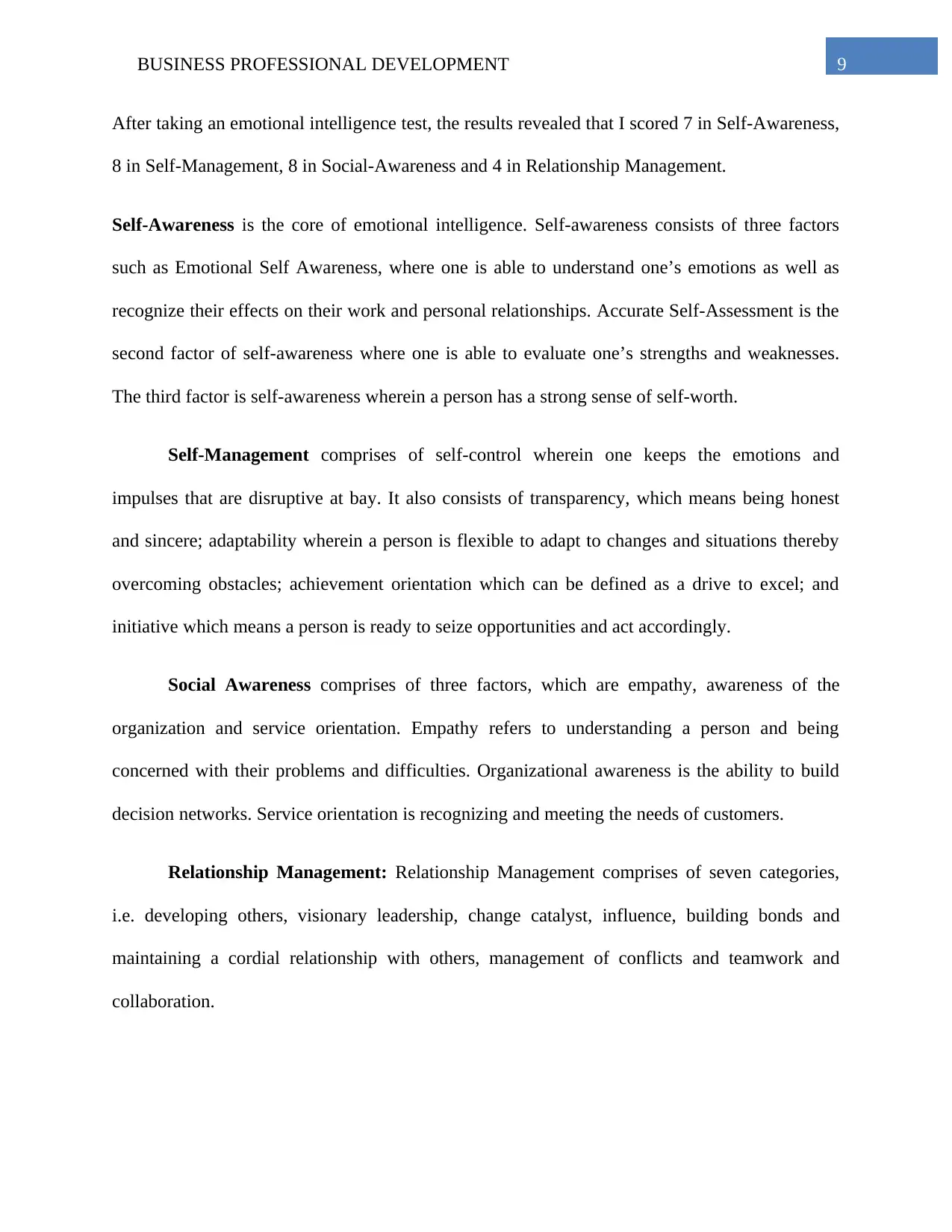
9BUSINESS PROFESSIONAL DEVELOPMENT
After taking an emotional intelligence test, the results revealed that I scored 7 in Self-Awareness,
8 in Self-Management, 8 in Social-Awareness and 4 in Relationship Management.
Self-Awareness is the core of emotional intelligence. Self-awareness consists of three factors
such as Emotional Self Awareness, where one is able to understand one’s emotions as well as
recognize their effects on their work and personal relationships. Accurate Self-Assessment is the
second factor of self-awareness where one is able to evaluate one’s strengths and weaknesses.
The third factor is self-awareness wherein a person has a strong sense of self-worth.
Self-Management comprises of self-control wherein one keeps the emotions and
impulses that are disruptive at bay. It also consists of transparency, which means being honest
and sincere; adaptability wherein a person is flexible to adapt to changes and situations thereby
overcoming obstacles; achievement orientation which can be defined as a drive to excel; and
initiative which means a person is ready to seize opportunities and act accordingly.
Social Awareness comprises of three factors, which are empathy, awareness of the
organization and service orientation. Empathy refers to understanding a person and being
concerned with their problems and difficulties. Organizational awareness is the ability to build
decision networks. Service orientation is recognizing and meeting the needs of customers.
Relationship Management: Relationship Management comprises of seven categories,
i.e. developing others, visionary leadership, change catalyst, influence, building bonds and
maintaining a cordial relationship with others, management of conflicts and teamwork and
collaboration.
After taking an emotional intelligence test, the results revealed that I scored 7 in Self-Awareness,
8 in Self-Management, 8 in Social-Awareness and 4 in Relationship Management.
Self-Awareness is the core of emotional intelligence. Self-awareness consists of three factors
such as Emotional Self Awareness, where one is able to understand one’s emotions as well as
recognize their effects on their work and personal relationships. Accurate Self-Assessment is the
second factor of self-awareness where one is able to evaluate one’s strengths and weaknesses.
The third factor is self-awareness wherein a person has a strong sense of self-worth.
Self-Management comprises of self-control wherein one keeps the emotions and
impulses that are disruptive at bay. It also consists of transparency, which means being honest
and sincere; adaptability wherein a person is flexible to adapt to changes and situations thereby
overcoming obstacles; achievement orientation which can be defined as a drive to excel; and
initiative which means a person is ready to seize opportunities and act accordingly.
Social Awareness comprises of three factors, which are empathy, awareness of the
organization and service orientation. Empathy refers to understanding a person and being
concerned with their problems and difficulties. Organizational awareness is the ability to build
decision networks. Service orientation is recognizing and meeting the needs of customers.
Relationship Management: Relationship Management comprises of seven categories,
i.e. developing others, visionary leadership, change catalyst, influence, building bonds and
maintaining a cordial relationship with others, management of conflicts and teamwork and
collaboration.
Secure Best Marks with AI Grader
Need help grading? Try our AI Grader for instant feedback on your assignments.
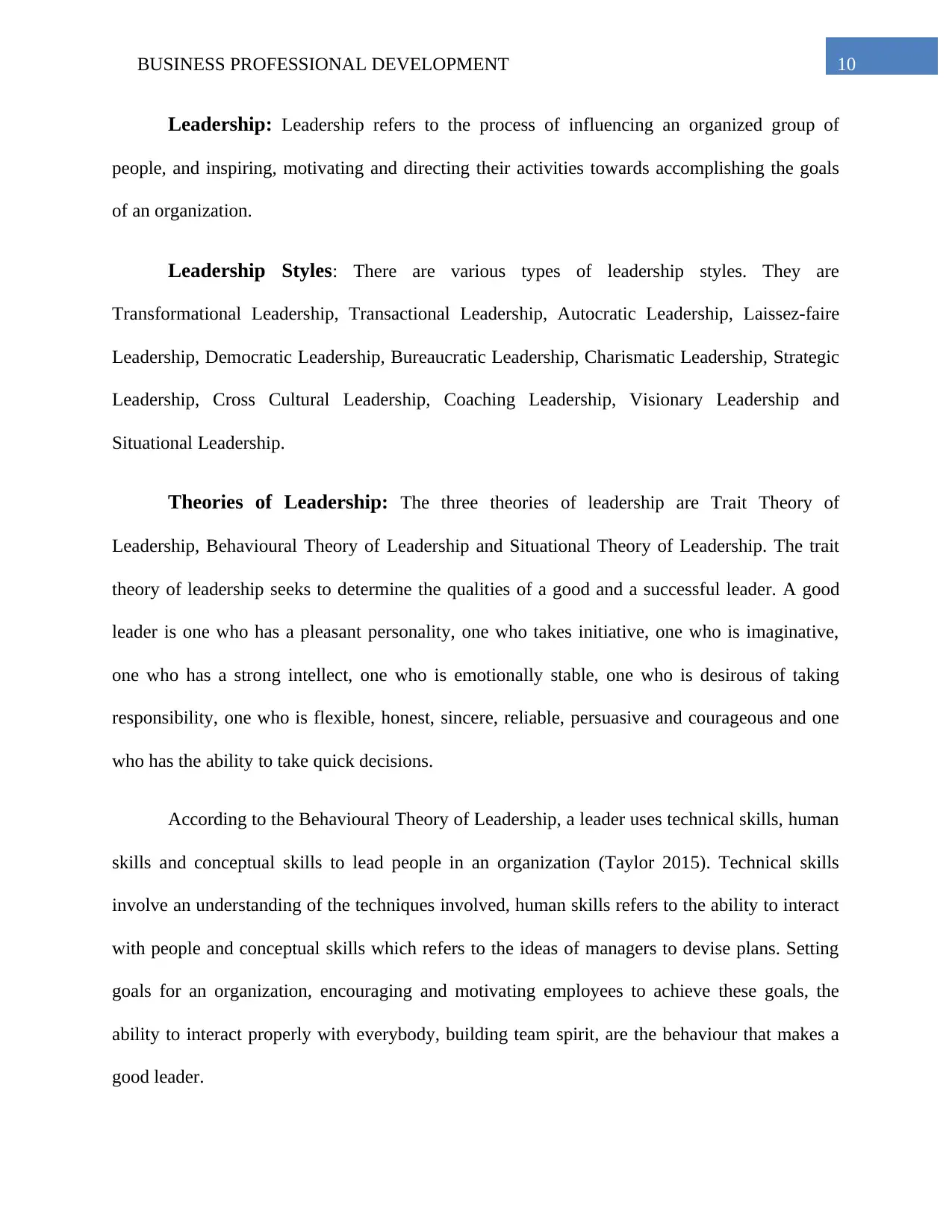
10BUSINESS PROFESSIONAL DEVELOPMENT
Leadership: Leadership refers to the process of influencing an organized group of
people, and inspiring, motivating and directing their activities towards accomplishing the goals
of an organization.
Leadership Styles: There are various types of leadership styles. They are
Transformational Leadership, Transactional Leadership, Autocratic Leadership, Laissez-faire
Leadership, Democratic Leadership, Bureaucratic Leadership, Charismatic Leadership, Strategic
Leadership, Cross Cultural Leadership, Coaching Leadership, Visionary Leadership and
Situational Leadership.
Theories of Leadership: The three theories of leadership are Trait Theory of
Leadership, Behavioural Theory of Leadership and Situational Theory of Leadership. The trait
theory of leadership seeks to determine the qualities of a good and a successful leader. A good
leader is one who has a pleasant personality, one who takes initiative, one who is imaginative,
one who has a strong intellect, one who is emotionally stable, one who is desirous of taking
responsibility, one who is flexible, honest, sincere, reliable, persuasive and courageous and one
who has the ability to take quick decisions.
According to the Behavioural Theory of Leadership, a leader uses technical skills, human
skills and conceptual skills to lead people in an organization (Taylor 2015). Technical skills
involve an understanding of the techniques involved, human skills refers to the ability to interact
with people and conceptual skills which refers to the ideas of managers to devise plans. Setting
goals for an organization, encouraging and motivating employees to achieve these goals, the
ability to interact properly with everybody, building team spirit, are the behaviour that makes a
good leader.
Leadership: Leadership refers to the process of influencing an organized group of
people, and inspiring, motivating and directing their activities towards accomplishing the goals
of an organization.
Leadership Styles: There are various types of leadership styles. They are
Transformational Leadership, Transactional Leadership, Autocratic Leadership, Laissez-faire
Leadership, Democratic Leadership, Bureaucratic Leadership, Charismatic Leadership, Strategic
Leadership, Cross Cultural Leadership, Coaching Leadership, Visionary Leadership and
Situational Leadership.
Theories of Leadership: The three theories of leadership are Trait Theory of
Leadership, Behavioural Theory of Leadership and Situational Theory of Leadership. The trait
theory of leadership seeks to determine the qualities of a good and a successful leader. A good
leader is one who has a pleasant personality, one who takes initiative, one who is imaginative,
one who has a strong intellect, one who is emotionally stable, one who is desirous of taking
responsibility, one who is flexible, honest, sincere, reliable, persuasive and courageous and one
who has the ability to take quick decisions.
According to the Behavioural Theory of Leadership, a leader uses technical skills, human
skills and conceptual skills to lead people in an organization (Taylor 2015). Technical skills
involve an understanding of the techniques involved, human skills refers to the ability to interact
with people and conceptual skills which refers to the ideas of managers to devise plans. Setting
goals for an organization, encouraging and motivating employees to achieve these goals, the
ability to interact properly with everybody, building team spirit, are the behaviour that makes a
good leader.
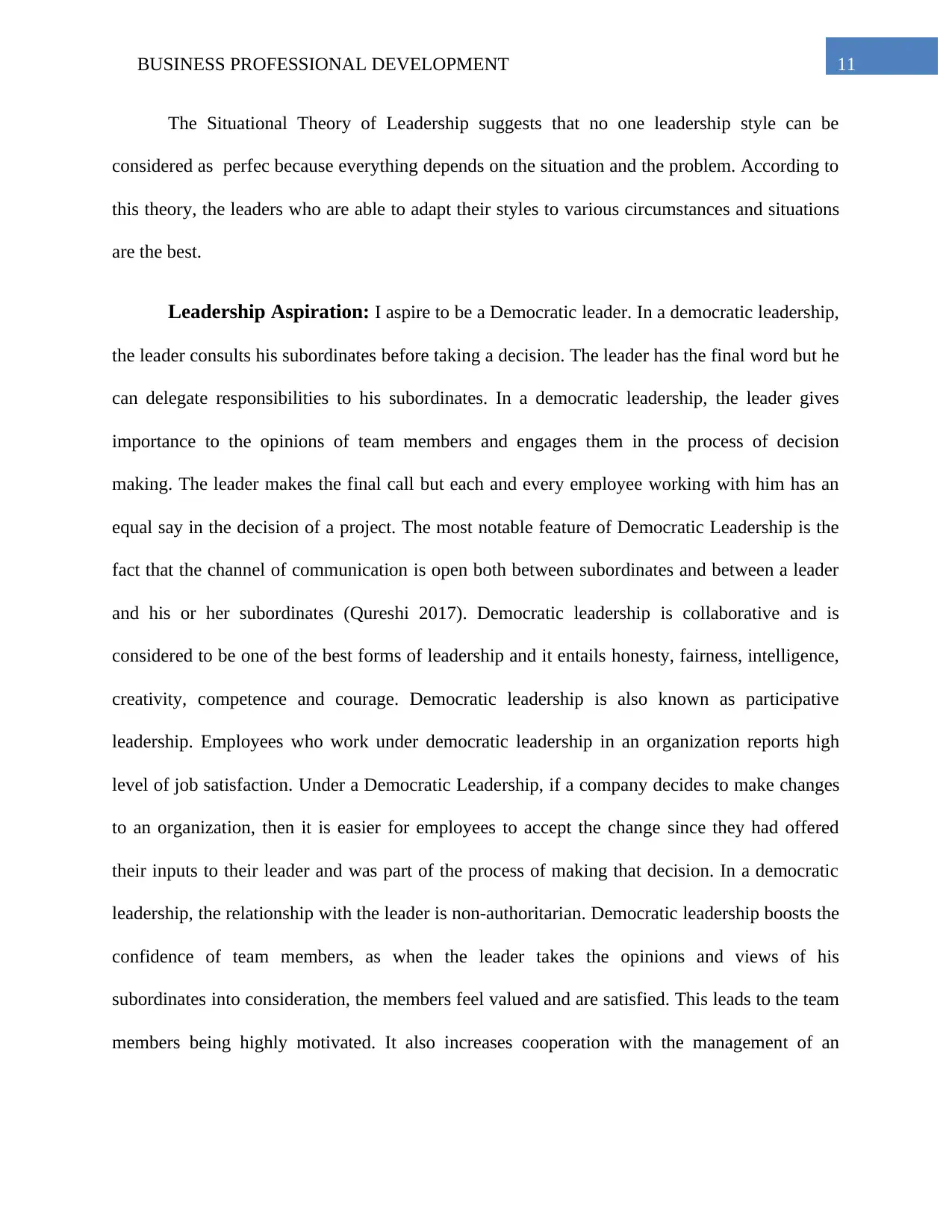
11BUSINESS PROFESSIONAL DEVELOPMENT
The Situational Theory of Leadership suggests that no one leadership style can be
considered as perfec because everything depends on the situation and the problem. According to
this theory, the leaders who are able to adapt their styles to various circumstances and situations
are the best.
Leadership Aspiration: I aspire to be a Democratic leader. In a democratic leadership,
the leader consults his subordinates before taking a decision. The leader has the final word but he
can delegate responsibilities to his subordinates. In a democratic leadership, the leader gives
importance to the opinions of team members and engages them in the process of decision
making. The leader makes the final call but each and every employee working with him has an
equal say in the decision of a project. The most notable feature of Democratic Leadership is the
fact that the channel of communication is open both between subordinates and between a leader
and his or her subordinates (Qureshi 2017). Democratic leadership is collaborative and is
considered to be one of the best forms of leadership and it entails honesty, fairness, intelligence,
creativity, competence and courage. Democratic leadership is also known as participative
leadership. Employees who work under democratic leadership in an organization reports high
level of job satisfaction. Under a Democratic Leadership, if a company decides to make changes
to an organization, then it is easier for employees to accept the change since they had offered
their inputs to their leader and was part of the process of making that decision. In a democratic
leadership, the relationship with the leader is non-authoritarian. Democratic leadership boosts the
confidence of team members, as when the leader takes the opinions and views of his
subordinates into consideration, the members feel valued and are satisfied. This leads to the team
members being highly motivated. It also increases cooperation with the management of an
The Situational Theory of Leadership suggests that no one leadership style can be
considered as perfec because everything depends on the situation and the problem. According to
this theory, the leaders who are able to adapt their styles to various circumstances and situations
are the best.
Leadership Aspiration: I aspire to be a Democratic leader. In a democratic leadership,
the leader consults his subordinates before taking a decision. The leader has the final word but he
can delegate responsibilities to his subordinates. In a democratic leadership, the leader gives
importance to the opinions of team members and engages them in the process of decision
making. The leader makes the final call but each and every employee working with him has an
equal say in the decision of a project. The most notable feature of Democratic Leadership is the
fact that the channel of communication is open both between subordinates and between a leader
and his or her subordinates (Qureshi 2017). Democratic leadership is collaborative and is
considered to be one of the best forms of leadership and it entails honesty, fairness, intelligence,
creativity, competence and courage. Democratic leadership is also known as participative
leadership. Employees who work under democratic leadership in an organization reports high
level of job satisfaction. Under a Democratic Leadership, if a company decides to make changes
to an organization, then it is easier for employees to accept the change since they had offered
their inputs to their leader and was part of the process of making that decision. In a democratic
leadership, the relationship with the leader is non-authoritarian. Democratic leadership boosts the
confidence of team members, as when the leader takes the opinions and views of his
subordinates into consideration, the members feel valued and are satisfied. This leads to the team
members being highly motivated. It also increases cooperation with the management of an
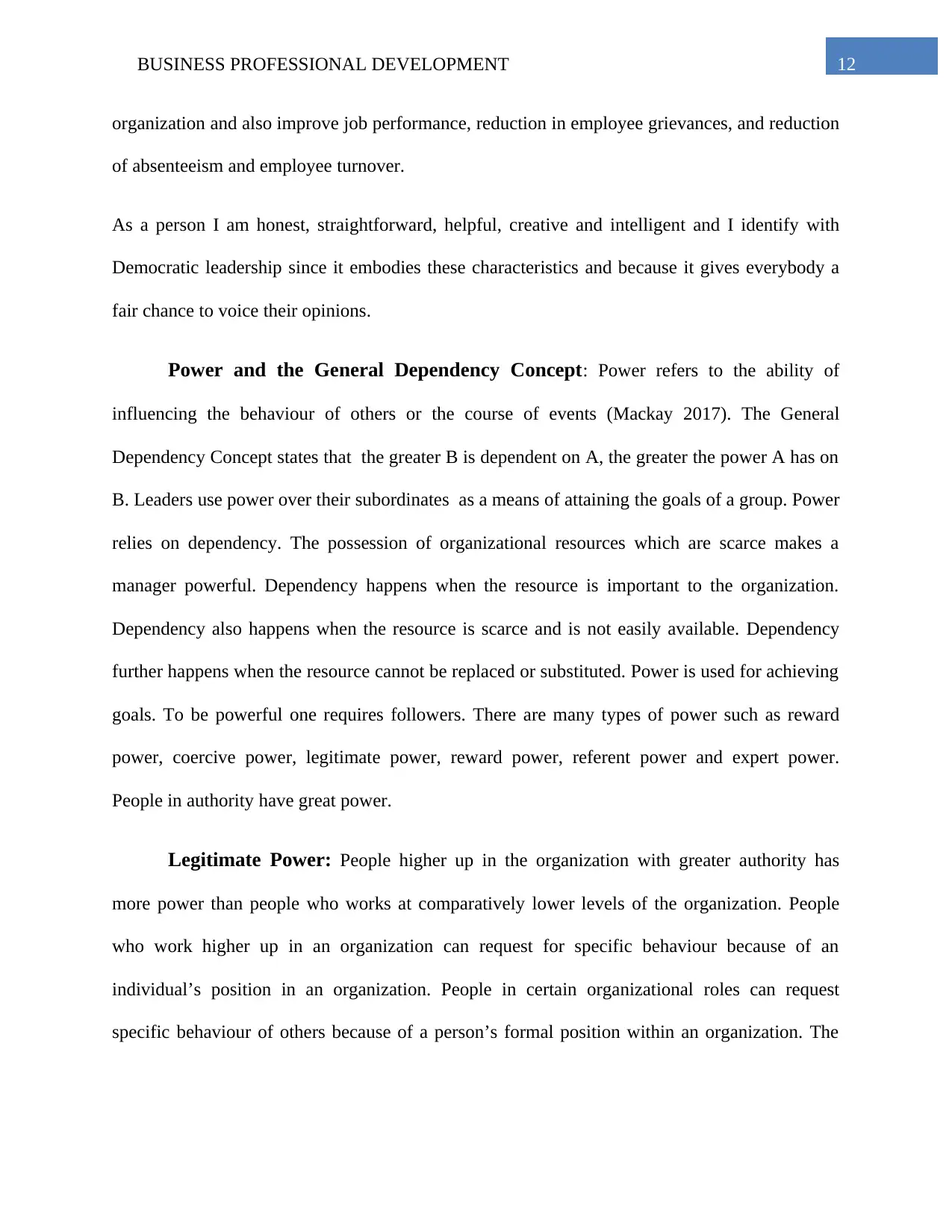
12BUSINESS PROFESSIONAL DEVELOPMENT
organization and also improve job performance, reduction in employee grievances, and reduction
of absenteeism and employee turnover.
As a person I am honest, straightforward, helpful, creative and intelligent and I identify with
Democratic leadership since it embodies these characteristics and because it gives everybody a
fair chance to voice their opinions.
Power and the General Dependency Concept: Power refers to the ability of
influencing the behaviour of others or the course of events (Mackay 2017). The General
Dependency Concept states that the greater B is dependent on A, the greater the power A has on
B. Leaders use power over their subordinates as a means of attaining the goals of a group. Power
relies on dependency. The possession of organizational resources which are scarce makes a
manager powerful. Dependency happens when the resource is important to the organization.
Dependency also happens when the resource is scarce and is not easily available. Dependency
further happens when the resource cannot be replaced or substituted. Power is used for achieving
goals. To be powerful one requires followers. There are many types of power such as reward
power, coercive power, legitimate power, reward power, referent power and expert power.
People in authority have great power.
Legitimate Power: People higher up in the organization with greater authority has
more power than people who works at comparatively lower levels of the organization. People
who work higher up in an organization can request for specific behaviour because of an
individual’s position in an organization. People in certain organizational roles can request
specific behaviour of others because of a person’s formal position within an organization. The
organization and also improve job performance, reduction in employee grievances, and reduction
of absenteeism and employee turnover.
As a person I am honest, straightforward, helpful, creative and intelligent and I identify with
Democratic leadership since it embodies these characteristics and because it gives everybody a
fair chance to voice their opinions.
Power and the General Dependency Concept: Power refers to the ability of
influencing the behaviour of others or the course of events (Mackay 2017). The General
Dependency Concept states that the greater B is dependent on A, the greater the power A has on
B. Leaders use power over their subordinates as a means of attaining the goals of a group. Power
relies on dependency. The possession of organizational resources which are scarce makes a
manager powerful. Dependency happens when the resource is important to the organization.
Dependency also happens when the resource is scarce and is not easily available. Dependency
further happens when the resource cannot be replaced or substituted. Power is used for achieving
goals. To be powerful one requires followers. There are many types of power such as reward
power, coercive power, legitimate power, reward power, referent power and expert power.
People in authority have great power.
Legitimate Power: People higher up in the organization with greater authority has
more power than people who works at comparatively lower levels of the organization. People
who work higher up in an organization can request for specific behaviour because of an
individual’s position in an organization. People in certain organizational roles can request
specific behaviour of others because of a person’s formal position within an organization. The
Paraphrase This Document
Need a fresh take? Get an instant paraphrase of this document with our AI Paraphraser

13BUSINESS PROFESSIONAL DEVELOPMENT
higher up in an organization a person is, the more legitimate power they possess. Power that is
legitimate is exercised through requests and demands.
Coercive Power: Coercive power is the power that influence others through the ability
and fear of punishment. Coercive power depends on fear. Coercive power results in negative
feelings as it leads to hostility and negativity.
Reward Power: Reward power can be defined as the power which is exercised by
meting out rewards to people. Rewards can be either financial or non-financial. Financial
rewards includes benefits and salary bonuses while non-financial rewards include praise that is
meted out to people, assigning assignments that are interesting, recognition and work shifts that
the employees prefer.
Expert power: Expert power can be defined as the power to influence others due to a
person’s skill, knowledge or expertise. People who are able to influence others because of their
relative expertise have the onus of expert power for example the CEO of a company.
Referent Power: Referent power refers to the power that is exerted by an individual on
others because of his/her charming personality. People admire such leaders and consider such
leaders to be a role model. People comply because of loyalty, respect and admiration towards a
leader.
Influence: A leader can influence his or her subordinates by Rational persuasion,
Inspirational appeals, Pressure, Consultation, Ingratiation, Exchange and Legitimacy.
Politics: Political behaviour is of two types. They include Legitimate political behaviour
and Illegitimate political behaviour (Ho 2014). Legitimate political behaviour includes non
higher up in an organization a person is, the more legitimate power they possess. Power that is
legitimate is exercised through requests and demands.
Coercive Power: Coercive power is the power that influence others through the ability
and fear of punishment. Coercive power depends on fear. Coercive power results in negative
feelings as it leads to hostility and negativity.
Reward Power: Reward power can be defined as the power which is exercised by
meting out rewards to people. Rewards can be either financial or non-financial. Financial
rewards includes benefits and salary bonuses while non-financial rewards include praise that is
meted out to people, assigning assignments that are interesting, recognition and work shifts that
the employees prefer.
Expert power: Expert power can be defined as the power to influence others due to a
person’s skill, knowledge or expertise. People who are able to influence others because of their
relative expertise have the onus of expert power for example the CEO of a company.
Referent Power: Referent power refers to the power that is exerted by an individual on
others because of his/her charming personality. People admire such leaders and consider such
leaders to be a role model. People comply because of loyalty, respect and admiration towards a
leader.
Influence: A leader can influence his or her subordinates by Rational persuasion,
Inspirational appeals, Pressure, Consultation, Ingratiation, Exchange and Legitimacy.
Politics: Political behaviour is of two types. They include Legitimate political behaviour
and Illegitimate political behaviour (Ho 2014). Legitimate political behaviour includes non
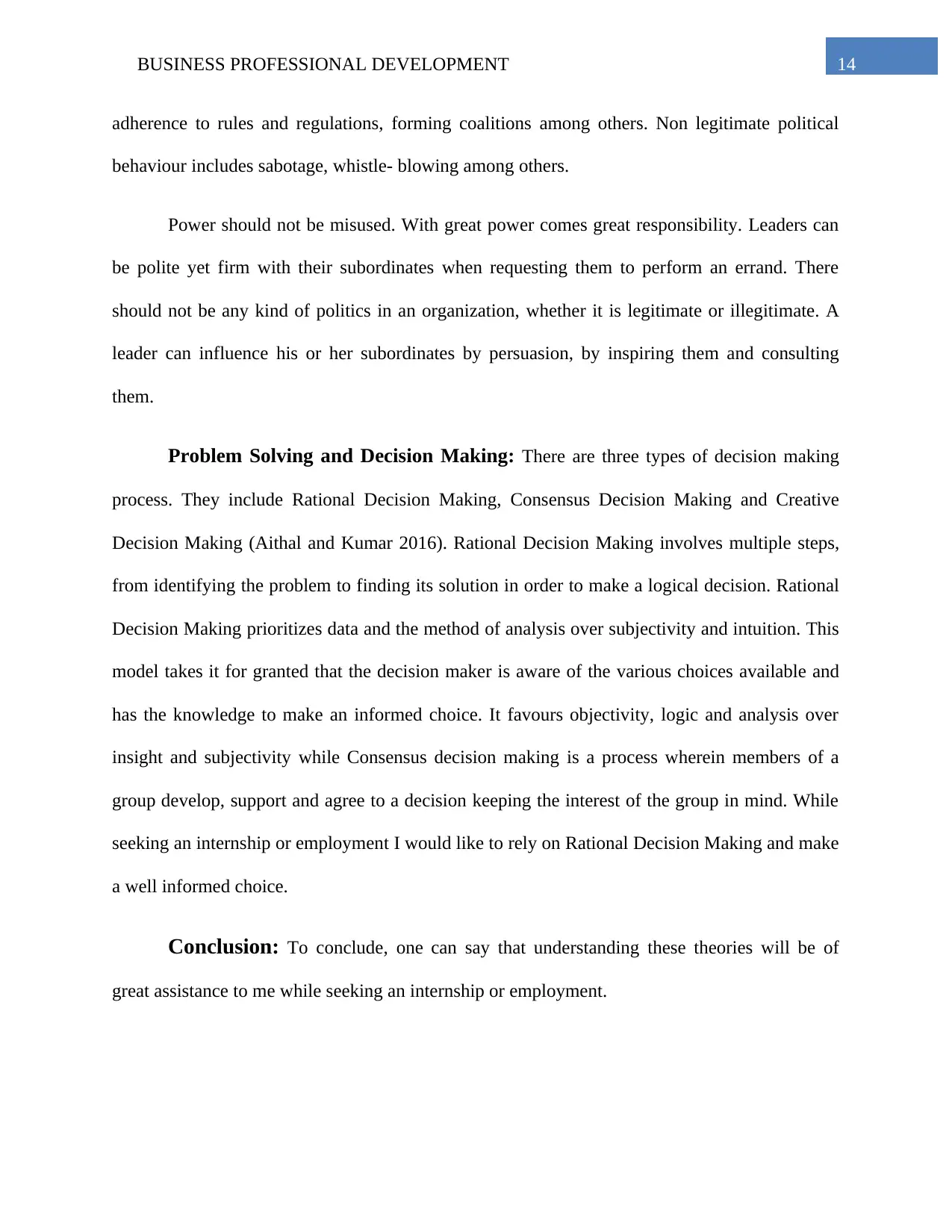
14BUSINESS PROFESSIONAL DEVELOPMENT
adherence to rules and regulations, forming coalitions among others. Non legitimate political
behaviour includes sabotage, whistle- blowing among others.
Power should not be misused. With great power comes great responsibility. Leaders can
be polite yet firm with their subordinates when requesting them to perform an errand. There
should not be any kind of politics in an organization, whether it is legitimate or illegitimate. A
leader can influence his or her subordinates by persuasion, by inspiring them and consulting
them.
Problem Solving and Decision Making: There are three types of decision making
process. They include Rational Decision Making, Consensus Decision Making and Creative
Decision Making (Aithal and Kumar 2016). Rational Decision Making involves multiple steps,
from identifying the problem to finding its solution in order to make a logical decision. Rational
Decision Making prioritizes data and the method of analysis over subjectivity and intuition. This
model takes it for granted that the decision maker is aware of the various choices available and
has the knowledge to make an informed choice. It favours objectivity, logic and analysis over
insight and subjectivity while Consensus decision making is a process wherein members of a
group develop, support and agree to a decision keeping the interest of the group in mind. While
seeking an internship or employment I would like to rely on Rational Decision Making and make
a well informed choice.
Conclusion: To conclude, one can say that understanding these theories will be of
great assistance to me while seeking an internship or employment.
adherence to rules and regulations, forming coalitions among others. Non legitimate political
behaviour includes sabotage, whistle- blowing among others.
Power should not be misused. With great power comes great responsibility. Leaders can
be polite yet firm with their subordinates when requesting them to perform an errand. There
should not be any kind of politics in an organization, whether it is legitimate or illegitimate. A
leader can influence his or her subordinates by persuasion, by inspiring them and consulting
them.
Problem Solving and Decision Making: There are three types of decision making
process. They include Rational Decision Making, Consensus Decision Making and Creative
Decision Making (Aithal and Kumar 2016). Rational Decision Making involves multiple steps,
from identifying the problem to finding its solution in order to make a logical decision. Rational
Decision Making prioritizes data and the method of analysis over subjectivity and intuition. This
model takes it for granted that the decision maker is aware of the various choices available and
has the knowledge to make an informed choice. It favours objectivity, logic and analysis over
insight and subjectivity while Consensus decision making is a process wherein members of a
group develop, support and agree to a decision keeping the interest of the group in mind. While
seeking an internship or employment I would like to rely on Rational Decision Making and make
a well informed choice.
Conclusion: To conclude, one can say that understanding these theories will be of
great assistance to me while seeking an internship or employment.

15BUSINESS PROFESSIONAL DEVELOPMENT
REFERENCES:
Aithal, P.S. and Kumar, P.M., 2016. Organizational Behaviour in 21st Century–'Theory A'for
Managing People for Performance.
Albers, P., Cho, A.R., Shin, J.H., Pang, M.E., Angay-Crowder, T., Odo, D.M., Jung, J.K., Pace,
C.L., Sena, M. and Turnbull, S., 2015. Critical spaces for critical times: Global conversations in
literacy research as an open professional development and practices resource. Global education
review, 2(3).
Boghikian-Whitby, S. and Mortagy, Y., 2016. Student preferences and performance in online
and face-to-face classes using Myers-Briggs Indicator: A longitudinal quasi-experimental study.
Issues in Informing Science and Information Technology, 13, pp.89-109.
Dixon, F.A., Yssel, N., McConnell, J.M. and Hardin, T., 2014. Differentiated instruction,
professional development, and teacher efficacy. Journal for the Education of the Gifted, 37(2),
pp.111-127.
Ho, J.K.K., 2014. A theoretical review on the professional development to be a scholar
practitioner in business management. European Academic Research, 1(12), pp.5393-5422.
Jones-Rikkers, C.G., 2014. Using Social Media and Professional Development Programs to
Enhance Student Acquisition of “Soft Skills”. M-PBEA Journal, p.9.
Judge, T.A., Higgins, C.A., Thoresen, C.J. and Barrick, M.R., 1999. The big five personality
traits, general mental ability, and career success across the life span. Personnel psychology,
52(3), pp.621-652.
Mackay, M., 2017. Identity formation: professional development in practice strengthens a sense
of self. Studies in Higher Education, 42(6), pp.1056-1070.
REFERENCES:
Aithal, P.S. and Kumar, P.M., 2016. Organizational Behaviour in 21st Century–'Theory A'for
Managing People for Performance.
Albers, P., Cho, A.R., Shin, J.H., Pang, M.E., Angay-Crowder, T., Odo, D.M., Jung, J.K., Pace,
C.L., Sena, M. and Turnbull, S., 2015. Critical spaces for critical times: Global conversations in
literacy research as an open professional development and practices resource. Global education
review, 2(3).
Boghikian-Whitby, S. and Mortagy, Y., 2016. Student preferences and performance in online
and face-to-face classes using Myers-Briggs Indicator: A longitudinal quasi-experimental study.
Issues in Informing Science and Information Technology, 13, pp.89-109.
Dixon, F.A., Yssel, N., McConnell, J.M. and Hardin, T., 2014. Differentiated instruction,
professional development, and teacher efficacy. Journal for the Education of the Gifted, 37(2),
pp.111-127.
Ho, J.K.K., 2014. A theoretical review on the professional development to be a scholar
practitioner in business management. European Academic Research, 1(12), pp.5393-5422.
Jones-Rikkers, C.G., 2014. Using Social Media and Professional Development Programs to
Enhance Student Acquisition of “Soft Skills”. M-PBEA Journal, p.9.
Judge, T.A., Higgins, C.A., Thoresen, C.J. and Barrick, M.R., 1999. The big five personality
traits, general mental ability, and career success across the life span. Personnel psychology,
52(3), pp.621-652.
Mackay, M., 2017. Identity formation: professional development in practice strengthens a sense
of self. Studies in Higher Education, 42(6), pp.1056-1070.
Secure Best Marks with AI Grader
Need help grading? Try our AI Grader for instant feedback on your assignments.
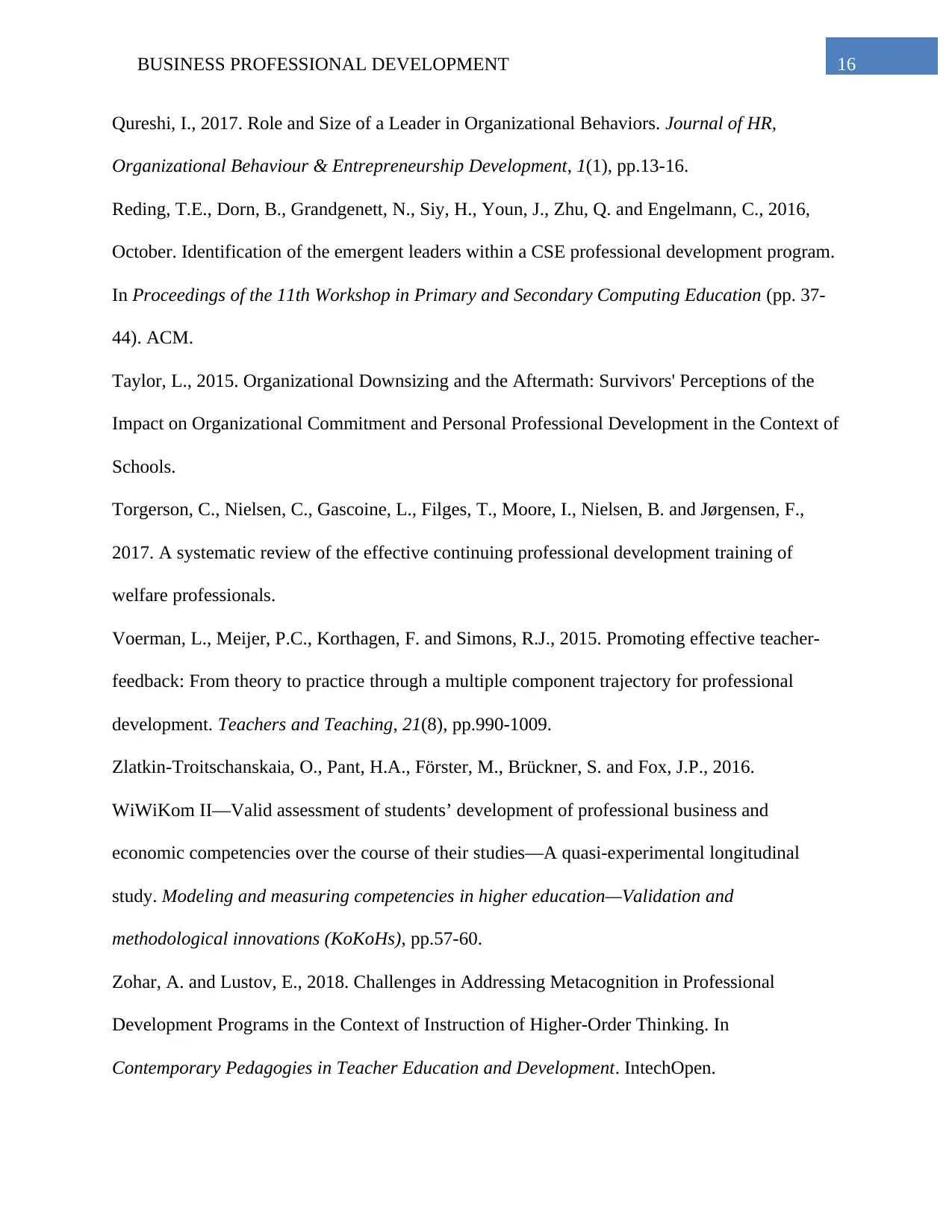
16BUSINESS PROFESSIONAL DEVELOPMENT
Qureshi, I., 2017. Role and Size of a Leader in Organizational Behaviors. Journal of HR,
Organizational Behaviour & Entrepreneurship Development, 1(1), pp.13-16.
Reding, T.E., Dorn, B., Grandgenett, N., Siy, H., Youn, J., Zhu, Q. and Engelmann, C., 2016,
October. Identification of the emergent leaders within a CSE professional development program.
In Proceedings of the 11th Workshop in Primary and Secondary Computing Education (pp. 37-
44). ACM.
Taylor, L., 2015. Organizational Downsizing and the Aftermath: Survivors' Perceptions of the
Impact on Organizational Commitment and Personal Professional Development in the Context of
Schools.
Torgerson, C., Nielsen, C., Gascoine, L., Filges, T., Moore, I., Nielsen, B. and Jørgensen, F.,
2017. A systematic review of the effective continuing professional development training of
welfare professionals.
Voerman, L., Meijer, P.C., Korthagen, F. and Simons, R.J., 2015. Promoting effective teacher-
feedback: From theory to practice through a multiple component trajectory for professional
development. Teachers and Teaching, 21(8), pp.990-1009.
Zlatkin-Troitschanskaia, O., Pant, H.A., Förster, M., Brückner, S. and Fox, J.P., 2016.
WiWiKom II—Valid assessment of students’ development of professional business and
economic competencies over the course of their studies—A quasi-experimental longitudinal
study. Modeling and measuring competencies in higher education—Validation and
methodological innovations (KoKoHs), pp.57-60.
Zohar, A. and Lustov, E., 2018. Challenges in Addressing Metacognition in Professional
Development Programs in the Context of Instruction of Higher-Order Thinking. In
Contemporary Pedagogies in Teacher Education and Development. IntechOpen.
Qureshi, I., 2017. Role and Size of a Leader in Organizational Behaviors. Journal of HR,
Organizational Behaviour & Entrepreneurship Development, 1(1), pp.13-16.
Reding, T.E., Dorn, B., Grandgenett, N., Siy, H., Youn, J., Zhu, Q. and Engelmann, C., 2016,
October. Identification of the emergent leaders within a CSE professional development program.
In Proceedings of the 11th Workshop in Primary and Secondary Computing Education (pp. 37-
44). ACM.
Taylor, L., 2015. Organizational Downsizing and the Aftermath: Survivors' Perceptions of the
Impact on Organizational Commitment and Personal Professional Development in the Context of
Schools.
Torgerson, C., Nielsen, C., Gascoine, L., Filges, T., Moore, I., Nielsen, B. and Jørgensen, F.,
2017. A systematic review of the effective continuing professional development training of
welfare professionals.
Voerman, L., Meijer, P.C., Korthagen, F. and Simons, R.J., 2015. Promoting effective teacher-
feedback: From theory to practice through a multiple component trajectory for professional
development. Teachers and Teaching, 21(8), pp.990-1009.
Zlatkin-Troitschanskaia, O., Pant, H.A., Förster, M., Brückner, S. and Fox, J.P., 2016.
WiWiKom II—Valid assessment of students’ development of professional business and
economic competencies over the course of their studies—A quasi-experimental longitudinal
study. Modeling and measuring competencies in higher education—Validation and
methodological innovations (KoKoHs), pp.57-60.
Zohar, A. and Lustov, E., 2018. Challenges in Addressing Metacognition in Professional
Development Programs in the Context of Instruction of Higher-Order Thinking. In
Contemporary Pedagogies in Teacher Education and Development. IntechOpen.
1 out of 17
Related Documents
Your All-in-One AI-Powered Toolkit for Academic Success.
+13062052269
info@desklib.com
Available 24*7 on WhatsApp / Email
![[object Object]](/_next/static/media/star-bottom.7253800d.svg)
Unlock your academic potential
© 2024 | Zucol Services PVT LTD | All rights reserved.



